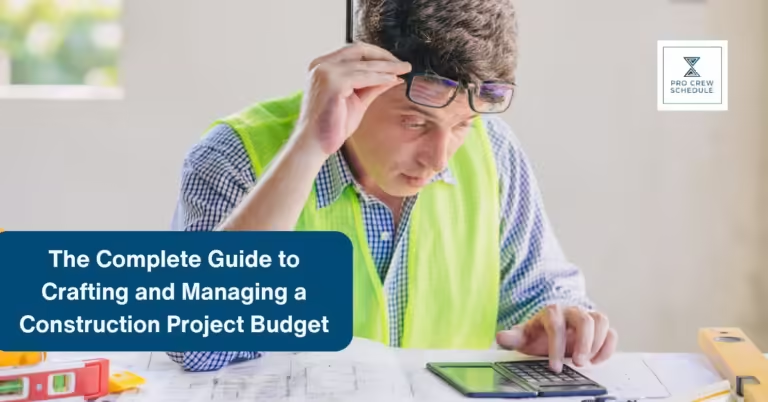When it comes to managing construction, every penny counts. So, to finish a job successfully, it is critical to be able to forecast and estimate accurately and keep track of your budget. Being in charge of a budget is an essential part of being a project manager. However, it might seem complicated to make and stick to a project budget, but it is not impossible if you have the right tools.
Setting up a budget is more than just making a list of numbers. It is an ongoing process that requires constant attention, fast decision-making skills and the ability to adapt to changing project needs. A well-thought-out budget that allows you to efficiently and effectively handle the tricky parts of building financing can make all the difference. In addition to ensuring the project stays within its budget, it can give the project the solid financial base it needs to grow.
In this article, we will discuss the essential parts of a construction budget, including what it is, how to make one, factors that affect it, ways to manage it, and problems that come up every day.
What Is A Construction Project Budget?
In a nutshell, a construction project budget is the total amount of money set aside and expected to be spent on a project over its entire life. It gives the project manager an overview of how much it will take to finish the project. It considers every scope, deliverable, material, and all the tasks associated with it. As a result, the budget forecast must be correct so that the project goes well and is cleared and funded on time. It takes a sensible approach to building by balancing the money that comes in and the money that goes out.
A well-thought-out budget is like a financial compass—it ensures that the project is finished on time, within the budget, and up to all standards and goals. It also keeps track of and moves the cash around constantly, so there is always financial openness and control.
Another part of the construction project budget is monitoring prices as you work. Costs can quickly get out of hand if you do not have a clear picture of your spending. In today’s world, most companies utilize the power of project management software to get a good overview of the project. It offers real-time data to track costs as they occur and gives project managers time to make changes to stay on budget.
The Importance of Construction Project Budget
As mentioned earlier, a construction budget is like a road map for money as it shows precisely where the project’s money is going. It gives project managers and other important people involved:
- The power to make intelligent choices.
- Set spending priorities.
- Change plans as needed to stay within budget.
It is necessary to ensure that the budget is well-thought-out to ensure that your project’s profitability is maintained. This is also to avoid possible delays in the project if you do not have the right number of resources at the right time.
What Are The Parts of a Construction Project Budget?
A construction project budget is made up of several essential parts that have a significant impact on the project’s finances. In this section, let us define them:
Direct costs
Costs are those that directly affect the building, such as labor, materials, and machine rentals.
Indirect Costs
When you build something, you have to pay for things like permits, insurance, and site security. These are considered as indirect costs.
Contingency Funds
Because the construction industry is highly volatile and building is unpredictable, a contingency reserve is set aside to cover unexpected costs or time overruns.
Profit Margin
A budget also shows how much money you plan to make from the project, which is a significant number to keep track of throughout the process.
When you look at how the construction budgeting process works, it is clear that a budget is more than just keeping track of costs. It is a strategic tool that ensures projects can be funded, risks are handled, and resources are used well.
Factors That Affect the Construction Project Budget
When you make a budget for a construction project, you have to make accurate predictions. This means that the budget has to take into account unknowns and variables that change over time, so it has to be constantly adjusted and reevaluated.
Not only do these things need to be considered during the early stages of the planning process, but they also need to be continuously monitored, as prices can fluctuate as the project goes on. As a result, it is essential to understand these things when making a flexible and practical budget that can be changed as needed.
Market Trends and Material Costs
The main factor affecting construction budgets is the cost of materials, and market trends significantly affect these prices. Material prices can change significantly over time because of changes in supply and demand, global events, and the economy. Project managers must account for possible price increases and adjust accordingly.
Location and Environment
Usually, the location and environment of a construction job have a significant effect on how much it costs. Things like terrain, climate, and how easy it is to get to can all affect the building methods, materials used, and, in the end, the prices.
Rules and Regulations
Every construction project must follow regulatory and compliance standards, which can be very different depending on the authority having jurisdiction. These rules usually cover many other areas, such as worker safety, protecting the environment, and building codes.
Challenges When it Comes to Managing Project Budget
Precision planning, constant change, and solid financial oversight are all parts of good construction budget management. Setting up and managing something requires a lot of accuracy and adaptability. However, no matter how much planning you do, sometimes things can go out of hand.
Misallocation of Costs for the Job
Job costing systems can hide a project’s actual financial state if costs are not tracked correctly to the correct cost tags. This makes it hard to see where funds are being spent and how well they match the planned budget. When costs are not correctly categorized, financial analysis is more complex, making it harder to find places where money is being wasted or to make changes to strategies before they happen.
Dealing with Unexpected Costs
Unexpected costs can come from many different sources and test the best-laid financial plans. Project budgets need to be able to handle these costs, and more than traditional budgeting methods are required in order to deal with these shocks. This is where contingency funds come in. These funds keep projects’ finances stable even if they have to pay for unforeseen expenses.
Inaccurate and Understated Costs
Costs are understated when your initial budget only partially captures the full scope of the project’s costs or adequately predicts the possibility of costs that should have been planned for. Underestimating can put a lot of pressure on the budget, which can lead to financial overruns that threaten the end of the project and the economy as a whole.
How to Create a Construction Project Budget?
As mentioned earlier, it is essential to make it easy to keep track of all the line items in a project budget. In this section, we will show you how to create a project budget in a few simple steps.
Itemize Your Expenses
To make a budget, the first thing you need to do is list your costs. You need to make a list of everything that needs to be done to finish a job. This includes the cost of work, tools, materials, and other things. You should carefully look over your project plan and figure out the costs by yourself to begin.
Estimate Costs
Now, rate each item on your list. You can come up with your predictions in a number of different ways. These are the most popular ways to estimate:
- Bottom-Up Estimating
List the parts of each job and then add them all up. You can consult the pros on your team to determine the cost of a job.
- Analogous Estimating
This time, use your past work to estimate the cost of the project jobs.
Include Extra Funding
Most construction projects can take up to a few months to complete, with bigger and more complex ones running for years. Consider a bit of extra budget since there are a lot of factors that can affect the prices as the project runs. You could still add:
- Management Reserves
This is a fund that management can use as they see fit. It can cover change orders or emergency expenses.
- Contingency
Contingency costs help cover unexpected costs resulting from inadequate planning. Adding an extra 10% is a standard precaution in case the estimates turn out to be wrong.
- Risk Response Budget
If your company is skilled at handling project risk, you can add the risk response budget separately from your central budget. The budget for risk response includes money to pay for any steps that lower the risk.







